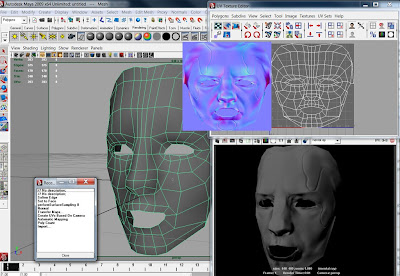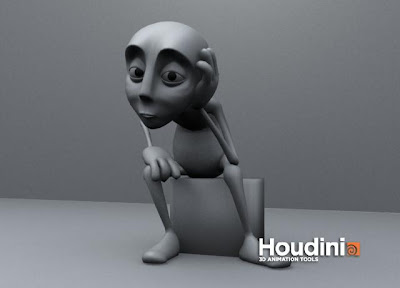Part duex of the CGcon notes:
Jeff Miller (Zbrush)
http://redrepublik.cgsociety.org/gallery/665298
Start with z-spheres, retopo later if you need to
z-spheres (preview mesh "A" -> make polymesh3d when you want to convert from z-sphere to poly)
Reuses basemesh created from zspheres for many different characters, posing them differently using the transpose tool
For facial modeling he uses clay tube brush + some gravity on the brush for wrinkles
Uses claty tubes for putting in muscle -> smooth them out (clay smooth)
Use clay for filling in volume
When masking it is sometimes better to do it at lowest subD level to make it as precise as possible
Use falloff brush from zbrushcentral vs pinch brush (pinches topology = bad)
To create stylized hair use falloff + masking + flatten brush
Always step down to lowest subD level before saving! This insures better stability in file.
Subtool master has a one button click to step all the way down or up subD
The more tools you have in your zbrush tool palette the slower zbrush runs
You can separate / group you character according to UV shells (polygroup -> UVgroup split)
Don't just add detail around your entire character uniformly, add detail intelligently and in the right places
Typically spends a week on a character
Mask -> Create UVs (Makes UVmapping + Mask info)
Recommends modeling smaller scale / minor objects in package separate from zbrush
Cavity Masking stuff:
Masking -> Mask by cavity
Use cavity mask checkbox in brush menu drop down to activate cavity masking on brush stroke!
You can create a custom cavity mask in zmapper
Zmapper is only part of zbrush to utilize gpu (vs cpu + ram)
cavity maps can be good for making spec maps (simulates AO)
to make spec map: desaturate diffuse -> multiply cavity map -> add noise (dodge and burn)
Paint color with cavity mask: turn off Zadd and turn on RGB (RGB typically 1-50)
This way you can paint darker areas (dirt map) into recesses. Invert cavity mask to paint highlights. Use cavity masking checked on in brush stroke menu -> use dot spray -> use noisy alpha -> paint noisy grime across recessed detail (dirt in scales for armor)
Make scale alphas -> drag rect stroke to place scales (not projection master) -> cavity masking to paint in grime / emphasize depth
Armored hero here:
http://forums.cgsociety.org/showthr...06&page=1&pp=15
To export painted color as file use texture menu color-> texture button
Make sure to flip texture file vertically. Zbrush will alwys flip a file vertically the wrong way by default. You can use the texture menu drop down and flip V before exporting to fix this problem.
To prevent problems when creating normal maps in max make sure to load the right export preset when in Zmapper
Suggests using xnormal because it is topology independent. One could use the decimation master plugin on a sculpt to decimate hi rez sculpt for use in xnormal. Likes generating normal maps with xnormal over zmapper overall.
Lights character in max with omni light as rimlight (?!?)
Suggests plugging in HDR file in skylight for better bounce light / gradient
Tip: use blue specularity map for skin because it complements warm skin tones well.
Use same color spec for metal (blue metal -> blue spec map)
*****
General Tips (Thanks Daniel!)
Use append rather than bridge in maya because bridge is still "broken"
there is no "connect" in maya but you can use triangulate -> quadrangulate
Maya 2009 now has LSCM unwrapping and UV color feedback (!!!)
Environment artists now start with GIANT texture sheet and then overlay model Uvs as they create the models (working macro to micro).
http://www.gionakpil.com/galleryDIGITAL.htm
Check vimeo channels for zbrush work
*****
Zack Petroc
http://www.zackpetroc.com/
every freelance artist is in business for himself and therefore is an independent studio unto themselves
story / character more important than any CG / effect
influenced by Matthew Barney
(note: Cremaster really is excellent / bizarre http://www.imdb.com/name/nm0056030/ )
influenced by Gregory Crewdson for storytelling ability
ultimately story drives EVERYTHING
Production designer in control of "visual look"
Art director has ultimate say in color / tone of shot
sets based on production design notes
Recommends paying a cheaper artist to create animatable mesh (retopo) over higher paid sculptor although this can often be the same artist
Worked at GM at car design facility (avg time to learn how to sculpt 5 years)
Stressed how good topology / animatable topology still very important to modeling.
Suggests these books:
George Bridgman's "Constructive Anatomy" and Fritz Schider's "An Atlas of Anatomy for Artists"
Rhino + cutting paths = cool sculpting pipeline
Suggested artists make assets with royalties attached whenever possible
worry less about what projects you get to work on but who you could be working with
Freelance = starting your own studio (same thing)
Use zbrush to explore / prototype easily with z spheres -> final digital maquette -> (retopo if necessary)
Alternatively box model in 3d package of choice and import into zbrush for starting point
Suggests learning anatomy through knowing insertion points and muscle groups
Use lazy mouse plus pinch brush (low intensity) to add detail / define edges. Note: ctrl + 1 will repeat stroke. Also note neither previous zbrush artist advocated pinch but rather the custom falloff brushes found on zbrush central.com
Use geometry -> crease to define open edgeloop edge before sudD
Create open edgeloop (separate geomety in zbrush!! / cut mesh along edge loop) like this: shift + F (turn on wireframe) -> perspective off -> lasso select on -> step to low subD -> lasso mask part of object along edge loop -> masking menu / hide PT -> geometry menu / edge loop (this separates visible into polygroup. Use ctrl + shift to toggle between polygroups. ctrl + shift + lmb on edge to hide edge ring (!!!) from here you can delete hidden or crease along hidden edge loop.
*****
Ian Joyner (Blur Studio / Iron Man)
http://kingmob.cgsociety.org/gallery/
designs in zbrush and photoshop
re-initializing zbrush will clear ztools. More ztools = zbrush runs slower
Make / utilize library of basemeshes for general shape
human basemesh should have fingers and extruded earsockets and eyesockets
when importing obj into zbrush make sure to have a primitive like the star or zsphere tool selected (otherwise point count won't match)
zbrush 4 will correct issues with the perspective view
use custom "muscle pinch" brush
clay used over standard brush most of time
morph brush good for painting back to stored morph target to try out different ideas
instead of always changing brush size just "zoom camera" (scale)
set perspective view to 120 for real world perspective
saves out layers as objs often
Makes a basic character in a day
Uses dot stroke at lower levels and freehand stoke at upper levels
post online often to get more freelance work
When using transpose rotate, alt LMB on dots to rotate around that dote
When using move brush hold down alt to insure move is along surfaces normal
Use clay brush to fill in between subtools
Recommends using polygroups because you can sculpt easily across polygroups vs subtools
When reprojecting new topo it is recommended you copy the original tool by using tool -> clone
This way a copy of original is kept. You can always clear out all unused custom ztools by re-initializing zbrush.
*****
Josh Robinson (Asylum Studios / Terminator 4)
Houdini used for rigging Terminator
Stressed one does not need to know how to draw in order to model in 3d
Highend hard surface modeling often means "kit bashing" older (high detail) models one massive high detail model
Terminator 4 pickup ship was a mashup of older ILM parts (?!?)
Swears by clay brush over standard brush.
Uses mask with flatten brush to create hard edges
Creates hard edge mask and then flatten -> inverts mask and then flattens again on other side
Alternatively you can make an alpha and/or mask and use geometry menu -> deform -> inflate



















